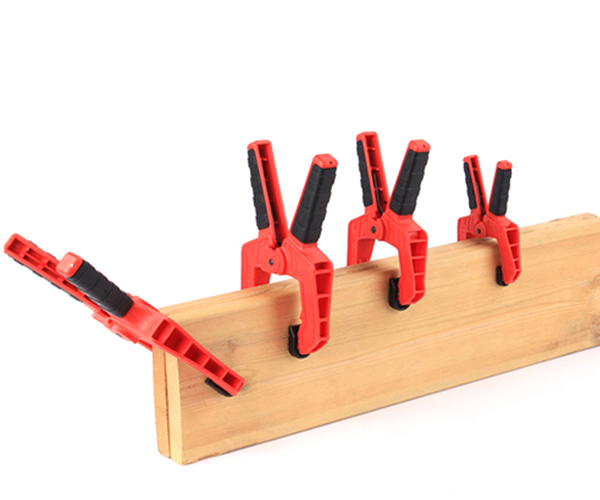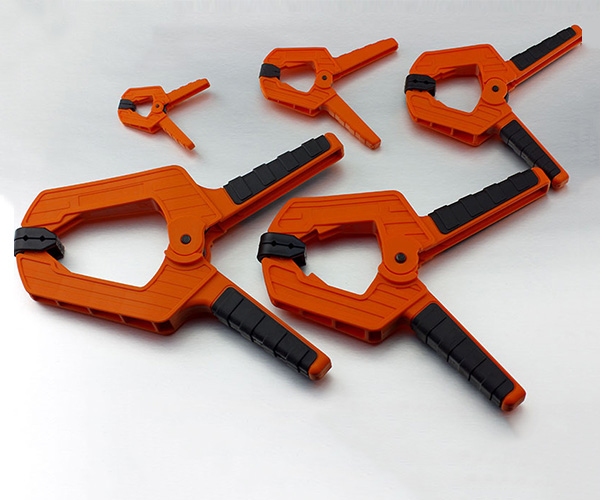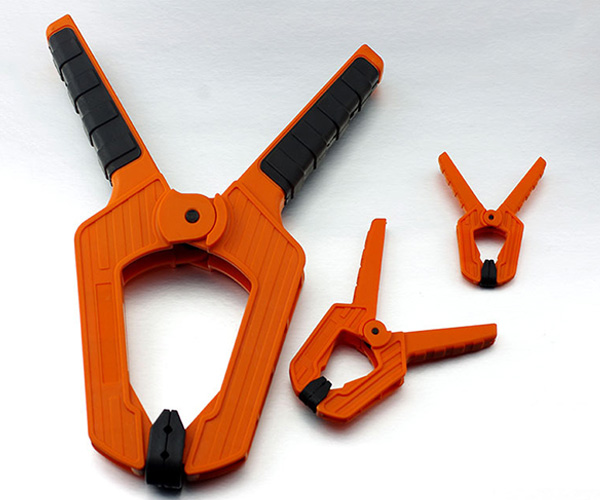Spring clamps are essential tools for many different applications, from woodworking to automotive repairs. If you’re looking to understand the versatility of these clamps, you’re in the right place. This article will guide you through the various uses of spring clamps, the benefits they offer, and how to choose the best one for your project.
1. What Are Spring Clamps?
Spring clamps are simple yet powerful tools designed to hold materials together by utilizing a spring mechanism. These clamps come in various sizes and are often used in situations that require a firm grip without needing a lot of pressure from the user.
But what makes spring clamps so effective? It’s their ability to maintain constant pressure on the object they’re clamping without the user needing to hold them in place. This makes them incredibly useful for tasks that need a steady hand. You might be wondering how they compare to other clamps, and here’s the answer: spring clamps are faster to use and offer a more convenient alternative to manual clamps for temporary holds.
The components of a spring clamp include the handles, jaws, and spring. The jaws are often coated with rubber or plastic to avoid damaging the surface of the materials they’re holding. The handles are spring-loaded, allowing the user to open and close the clamp easily. The tension in the spring is what allows the clamp to hold materials securely in place.
Spring clamps come in various sizes, ranging from small clamps perfect for crafting and light woodworking tasks to larger clamps that can be used in more heavy-duty projects like automotive repairs. Their versatility is unmatched, and they are one of the most affordable and accessible tools you can have in your toolbox.
2. Why Are Spring Clamps Useful in Woodworking?
When it comes to woodworking, precision and stability are key. Spring clamps offer both, allowing woodworkers to hold pieces of wood in place while working on them. The ability to secure pieces without using both hands frees up the woodworker to focus on their tasks, such as sanding, drilling, or gluing.
Here’s the kicker: spring clamps excel in applications that require a temporary hold. Unlike traditional clamps that may need to be manually tightened, spring clamps only require you to squeeze the handles, allowing you to position and secure your materials with ease.
For instance, if you’re gluing two pieces of wood together, you can use a spring clamp to hold them in place while the adhesive sets. The best part? They won’t slip or move during the drying process. Spring clamps also work well when you need to hold smaller pieces of wood for sanding or cutting.
Another advantage of using spring clamps in woodworking is that they come in various sizes, making them versatile for different tasks. Whether you’re working on a small project like picture framing or a larger project like building a bookshelf, spring clamps are up to the task.
3. How Do Spring Clamps Benefit Crafting Projects?
Crafting projects, whether it’s creating intricate jewelry or assembling models, often require delicate handling and precise positioning of materials. Spring clamps provide an easy solution to these problems, especially when working with small pieces that need to be temporarily held in place.
What’s the real story? Spring clamps make the crafting process faster and more efficient. Their quick-release mechanism allows crafters to secure materials quickly, enabling them to move on to the next step without wasting time. For example, when creating a DIY flower arrangement, spring clamps can hold individual stems in place while the designer arranges the rest of the display.
In addition, spring clamps can be particularly useful when working with fabric, leather, or other soft materials. They can hold the fabric steady while you sew or glue it, without causing any damage to the surface. Spring clamps also come in handy when working with small tools, like clamps for attaching beads in jewelry making. They offer a steady grip without obstructing the crafting process.
With their ability to handle delicate materials with precision, spring clamps make crafting projects easier and more enjoyable. Plus, they save valuable time in the process, which is always a win.
4. Can Spring Clamps Be Used in Automotive Repairs?
Automotive repairs often require clamps to hold parts in place while performing tasks like welding, painting, or assembling components. Spring clamps are perfect for such situations, offering a lightweight and easy-to-use solution for automotive professionals.
Ready for the good part? Spring clamps are often used to hold parts in place while the mechanic works with other tools. For example, they can hold automotive body panels in place during repairs or hold fabric upholstery while the technician sews it back together. These clamps are also handy when securing hoses or cables temporarily during repair work.
Spring clamps are especially beneficial when you need to make temporary adjustments during the repair process. When working in tight spaces, these clamps provide the convenience of quickly adjusting their position without requiring excessive effort.
For automotive repairs, spring clamps can also be used to secure seals, gaskets, and other components while you work on them. Whether you’re fixing a car’s interior or performing under-the-hood work, spring clamps help you keep things in place without hassle.

5. How to Choose the Right Spring Clamp for Your Project?
Choosing the right spring clamp depends on several factors, such as the size of the materials you’re working with, the amount of pressure needed, and the type of project you’re undertaking. For instance, if you’re working with delicate materials like fabric or softwoods, you may want to opt for a smaller clamp with rubberized tips to prevent damage.
Here’s where it gets interesting… The strength of the spring clamp is another crucial factor to consider. You’ll want a stronger spring for tasks that involve holding heavier materials, while a softer spring is sufficient for lighter tasks. Pay attention to the material of the clamp as well—clamps made of steel or other heavy-duty materials are great for tougher jobs, while lighter-duty clamps made from plastic are ideal for casual use.
Additionally, make sure the clamp can open wide enough to accommodate your materials. Some spring clamps offer a wider opening, while others are more limited in their range.
A good way to choose a spring clamp is by matching its size and strength with the requirements of your project. In general, a versatile set of spring clamps will give you flexibility for all sorts of tasks.
6. What Are the Advantages of Using Spring Clamps Over Other Clamps?
Spring clamps offer several advantages over other types of clamps. For one, they are incredibly quick and easy to use, requiring just a simple squeeze to engage. In contrast, other clamps, such as C-clamps or bar clamps, may require more time and effort to set up. This makes spring clamps a perfect option for projects that need to be completed quickly.
Additionally, spring clamps are compact and lightweight, which makes them easy to store and transport. They take up much less space in your toolbox compared to other clamps, making them ideal for smaller projects or when you’re working in a tight space. You’ll appreciate the portability when working on location or when moving between different areas of your workspace.
But here’s the kicker—spring clamps are also cost-effective, especially for those just starting with DIY projects or woodworking. They provide a great balance between price and performance, offering reliable clamping power without breaking the bank.
7. Can Spring Clamps Be Used for DIY Home Improvement Projects?
Yes, spring clamps are excellent for DIY home improvement projects. Whether you’re painting, installing trim, or doing basic repairs, spring clamps help you hold materials in place while you work.
Imagine this: you’re repainting your kitchen cabinets, and you need to hold the doors steady while you apply the paint. Spring clamps can secure the doors in place while you work, preventing them from shifting or wobbling. This way, you can focus on the job at hand without worrying about the materials moving out of position.
Spring clamps can also be used for more complex tasks, such as installing or replacing door hinges. By holding the door in place, they allow you to secure the hinges without needing an extra pair of hands. Their simplicity and ease of use make them perfect for all kinds of home improvement tasks, both big and small.
8. What Are the Different Sizes of Spring Clamps and When to Use Them?
Spring clamps come in various sizes, from tiny clamps suitable for small-scale crafts to large clamps for heavy-duty projects. Choosing the right size depends on the materials and the tasks at hand.
What’s the real story? Smaller spring clamps are perfect for holding delicate materials or small projects like jewelry-making or picture framing. On the other hand, larger spring clamps are ideal for woodworking, automotive repairs, or larger home improvement tasks, where more pressure is required to keep materials secure.
You’ll often find that a set of spring clamps with multiple sizes is ideal for versatility. That way, you can use the right clamp for every task, ensuring a secure grip without causing damage.
9. How to Properly Use Spring Clamps to Avoid Damage?
While spring clamps are easy to use, there are some best practices to follow to avoid damaging your materials. The most important thing is to apply the right amount of pressure. Applying too much force can result in bent materials or an uneven hold.
What’s the real story? To avoid damage, always start by adjusting the clamp so that it holds the material gently but securely. If the material you’re clamping is delicate, such as fabric or softwood, consider using a clamp with rubber tips to prevent imprints or abrasions.
It’s also important to avoid overtightening the clamp, as this can lead to distortion or stress marks on the surface of the material. Always use the right-sized clamp for the job, as clamps that are too large or too small may cause unnecessary stress.
10. Are There Any Limitations to Using Spring Clamps?
Despite their versatility, spring clamps do have limitations. They are best used for lightweight tasks that require a temporary hold. For projects that involve heavy-duty materials or permanent holds, other clamps like C-clamps or bar clamps may be better suited.
One limitation of spring clamps is their inability to provide a precise, even pressure across the entire surface. If you’re working on projects that require a highly uniform clamping force, a different type of clamp may be more effective.
But here’s the kicker: while spring clamps may not be perfect for every task, they are indispensable for quick fixes and temporary holds. Their ease of use and versatility make them a must-have tool in any workshop.

Conclusion
In this article, we’ve explored the many uses and benefits of spring clamps, including how they can simplify tasks in woodworking, crafting, automotive repairs, and DIY home improvement projects. Whether you’re securing materials, applying paint, or assembling parts, spring clamps offer a fast, easy, and cost-effective solution.
By choosing the right size and type of spring clamp for your projects, you can ensure a secure hold and achieve better results. Spring clamps may not be suitable for every job, but they are undeniably useful for many tasks.
FAQ
Q1: What is a spring clamp?
A spring clamp is a tool that uses a spring mechanism to hold materials tightly together. It is widely used in woodworking, crafting, automotive repairs, and DIY projects for a temporary hold.
Q2: How does a spring clamp work?
A spring clamp operates by using a spring-loaded mechanism that opens and closes the jaws of the clamp, allowing it to apply pressure on materials without requiring manual tightening.
Q3: What are the best applications for spring clamps?
Spring clamps are perfect for holding materials during woodworking, crafting, automotive repairs, home improvement tasks, and more, especially when a quick and temporary hold is needed.
Q4: Can spring clamps be used for metalworking?
Yes, spring clamps can be used for light metalworking tasks, although for heavy-duty applications, stronger clamps may be required.
Q5: How do I care for my spring clamps?
To care for your spring clamps, keep them clean and dry, lubricate the spring occasionally, and store them in a dry place to prevent rust or damage.





